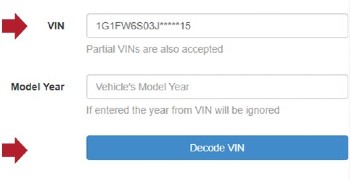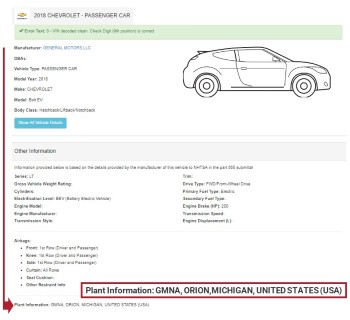Finding a car VIN number is essential for various reasons, from checking vehicle history to identifying specific car details. At CARS.EDU.VN, we provide comprehensive information about vehicle identification, VIN location, and decoding tips, ensuring you can confidently access vital information. Explore your vehicle’s history, specifications, and more with our expert guidance, and discover the importance of VIN verification and VIN lookup to make informed decisions.
1. Decoding the Mystery: What is a Car VIN Number?
A Vehicle Identification Number (VIN) is a unique 17-character code assigned to every motor vehicle. Think of it as a car’s fingerprint, providing a detailed history and description of the vehicle. This alphanumeric code contains a wealth of information, including the manufacturer, country of origin, year of manufacture, vehicle type, and specific features. Understanding the VIN allows you to unlock valuable insights about the car’s past and present.
1.1 Why is the VIN Important?
The VIN plays a crucial role in several key areas:
- Vehicle History: The VIN is used to track a vehicle’s history, including accidents, repairs, title transfers, and odometer readings. This information is crucial for potential buyers to assess the vehicle’s condition and avoid purchasing a car with hidden issues.
- Identification and Recall: The VIN uniquely identifies a specific vehicle, allowing manufacturers to issue recalls for safety-related defects. If a recall is issued for your vehicle’s VIN, you will be notified and the repair will be performed free of charge.
- Theft Prevention: VINs are used to track stolen vehicles, making it more difficult for thieves to sell or export them. Law enforcement agencies use VINs to identify and recover stolen cars.
- Insurance and Registration: Insurance companies and motor vehicle departments use VINs to identify vehicles, verify ownership, and track insurance claims.
1.2 The Anatomy of a VIN: Understanding the Code
Each section of the 17-character VIN provides specific information:
- Characters 1-3: World Manufacturer Identifier (WMI). This section identifies the vehicle’s manufacturer and country of origin.
- Characters 4-8: Vehicle Descriptor Section (VDS). This section describes the vehicle’s type, body style, engine, and other features.
- Character 9: Check Digit. This character is used to verify the VIN’s accuracy and authenticity.
- Character 10: Model Year. This character indicates the vehicle’s model year.
- Character 11: Assembly Plant. This character identifies the plant where the vehicle was assembled.
- Characters 12-17: Vehicle Serial Number. This section provides a unique serial number for the vehicle.
At CARS.EDU.VN, we break down the VIN structure in detail, helping you decipher the code and understand the information it contains.
2. Your Treasure Map: Common Car VIN Number Locations
Finding the VIN is usually straightforward. Here are the most common locations:
2.1 On the Dashboard
The most visible location is on the dashboard, near the windshield on the driver’s side. It’s visible from outside the car.
2.2 Driver’s Side Doorjamb
Open the driver’s side door and look for a sticker on the doorjamb. The VIN is often printed on this sticker along with other information like tire pressure.
2.3 Vehicle Title and Registration
The VIN is always printed on the vehicle’s title and registration documents. This is a convenient way to find the VIN if you don’t have physical access to the car.
2.4 Insurance Card
Your insurance card should also list the VIN of your vehicle.
2.5 Engine Block
The VIN might be stamped on the engine block, but this location can be difficult to access and find.
2.6 Vehicle Frame
On some vehicles, the VIN is stamped on the frame, but this is not a common location.
Quick Reference Table: Where to Look for Your VIN
| Location | Description | Accessibility |
|---|---|---|
| Dashboard | Near the windshield on the driver’s side, visible from outside the car. | Very Easy |
| Driver’s Side Doorjamb | Sticker on the doorjamb when the driver’s side door is opened. | Easy |
| Vehicle Title | Official document of ownership. | Easy (if available) |
| Vehicle Registration | Official document for legal vehicle operation. | Easy (if available) |
| Insurance Card | Provided by your insurance company. | Easy (if available) |
| Engine Block | Stamped on the engine block. | Difficult |
| Vehicle Frame | Stamped on the frame of the vehicle. | Difficult |


3. Decoding Your Car’s DNA: Online VIN Decoders
Once you’ve found the VIN, you can use online VIN decoders to unlock its secrets. These tools access databases that contain vehicle information associated with the VIN.
3.1 NHTSA VIN Decoder
The National Highway Traffic Safety Administration (NHTSA) provides a free VIN decoder on its website. This decoder provides basic information about the vehicle, including the make, model, year, and plant of manufacture.
3.2 CARFAX and AutoCheck
CARFAX and AutoCheck are commercial services that provide detailed vehicle history reports based on the VIN. These reports include information about accidents, repairs, title issues, odometer readings, and more. While these services charge a fee, the information they provide can be invaluable when purchasing a used car.
3.3 Third-Party VIN Decoder Websites
Numerous third-party websites offer VIN decoding services. Some are free, while others charge a fee for more detailed information. Be sure to choose a reputable website with accurate and up-to-date data.
Example of Online VIN Decoder Services
| Service | Cost | Information Provided |
|---|---|---|
| NHTSA | Free | Make, model, year, plant of manufacture |
| CARFAX | Fee-based | Accidents, repairs, title issues, odometer readings, number of owners |
| AutoCheck | Fee-based | Accidents, repairs, title issues, odometer readings, number of owners, comparison to other vehicles of the same make and model |
| EpicVIN | Free and Paid | Basic vehicle specifications, market value, and access to detailed vehicle history reports (paid). Offers insights into potential issues or discrepancies. |
| VINWiki | Free | Crowdsourced vehicle history information including photos, maintenance records, and stories from previous owners. |
4. Potential Roadblocks: Common Issues and How to Overcome Them
While finding and decoding a VIN is usually straightforward, some issues can arise.
4.1 VIN Not Found
If you can’t find the VIN in the usual locations, check other areas of the car, such as the engine block or frame. If the VIN is still missing, it’s possible the vehicle is stolen or has had its VIN altered.
4.2 VIN Doesn’t Decode
If the VIN doesn’t decode properly, double-check that you’ve entered it correctly. If the VIN still doesn’t decode, it could be a sign of a problem, such as a counterfeit VIN or an error in the database.
4.3 Discrepancies in Vehicle History
If the vehicle history report reveals discrepancies, such as unreported accidents or title issues, it’s important to investigate further. Consult with a mechanic or vehicle appraiser to assess the vehicle’s condition and determine if the discrepancies are a cause for concern.
4.4 VIN Cloning
VIN cloning is a form of vehicle theft where a stolen vehicle is given the VIN of a legitimate vehicle. This makes it difficult to identify the stolen vehicle and sell it to unsuspecting buyers. To protect yourself from VIN cloning, be sure to thoroughly inspect the vehicle and its documentation, and compare the VIN on the car to the VIN on the title and registration. If anything seems suspicious, walk away from the deal.
5. Real-World Scenarios: When You’ll Need Your VIN
The VIN is not just a random code; it’s a vital tool in many real-world scenarios.
5.1 Buying a Used Car
Before buying a used car, always obtain the VIN and run a vehicle history report. This will reveal any hidden issues, such as accidents, title problems, or odometer fraud.
5.2 Registering Your Car
When registering your car with the Department of Motor Vehicles (DMV), you’ll need to provide the VIN. The DMV uses the VIN to verify the vehicle’s identity and ensure it meets all legal requirements.
5.3 Insuring Your Car
Insurance companies use the VIN to identify your vehicle and determine your insurance rates.
5.4 Getting Your Car Repaired
When taking your car in for repairs, the mechanic will need the VIN to order the correct parts.
5.5 Checking for Recalls
You can use the VIN to check if your vehicle is subject to any safety recalls. Recalls are issued when a manufacturer discovers a safety-related defect in a vehicle. The manufacturer will notify you if your vehicle is subject to a recall, and the repair will be performed free of charge.
6. VIN Lookup: Step-by-Step Guide
Here’s a detailed step-by-step guide on how to perform a VIN lookup using the NHTSA VIN Decoder:
6.1 Step 1: Access the NHTSA VIN Decoder
- Open your web browser: Use Google Chrome, Mozilla Firefox, Safari, or any other web browser installed on your device.
- Navigate to the NHTSA VIN Decoder: Type the following URL into the address bar and press Enter:
https://vpic.nhtsa.dot.gov/decoder/
6.2 Step 2: Enter the VIN
- Locate the VIN: Find the 17-character VIN on the vehicle’s dashboard (driver’s side, near the windshield), doorjamb, or on your vehicle’s registration or insurance documents.
- Enter the VIN in the Decoder:
- On the NHTSA VIN Decoder page, you will see a text box labeled “Enter VIN.”
- Carefully type the 17-character VIN into the text box. Ensure that you enter the VIN correctly, as even a single incorrect character can lead to inaccurate results.
6.3 Step 3: Initiate the Decoding Process
- Click the “Decode VIN” Button: After entering the VIN, click the “Decode VIN” button located next to the text box.
6.4 Step 4: Review the Results
- Wait for the Results: The page will process your request and display the vehicle information based on the VIN you entered. This may take a few seconds.
- Examine the Vehicle Details: The results page will show various details about the vehicle, including:
- Make: The manufacturer of the vehicle (e.g., Toyota, Ford, Honda).
- Model: The specific model of the vehicle (e.g., Camry, F-150, Civic).
- Year: The model year of the vehicle (e.g., 2018, 2020, 2022).
- Plant of Manufacture: The location where the vehicle was manufactured.
- Vehicle Type: The type of vehicle (e.g., passenger car, truck, SUV).
- Other Specifications: Additional details about the vehicle’s features and specifications.
Important Notes:
- Accuracy:
- Ensure you have entered the VIN correctly to avoid inaccurate information.
- If the decoder does not return any results or shows an error, double-check the VIN and try again.
- Data Limitations:
- The NHTSA VIN Decoder provides basic information. For more detailed vehicle history, consider using services like CARFAX or AutoCheck.
- Contact the Manufacturer:
- If you have specific questions or need more detailed information, consider contacting the vehicle manufacturer directly.
- Regular Maintenance:
- Always keep your vehicle well-maintained to ensure it runs smoothly and safely. Refer to the manufacturer’s maintenance schedule for guidance.
By following these detailed steps, you can efficiently use the NHTSA VIN Decoder to obtain essential information about any vehicle. This information is crucial for making informed decisions, especially when buying a used car or verifying vehicle details.
7. Maximizing Your VIN Knowledge: Advanced Tips and Tricks
Here are some advanced tips and tricks to help you get the most out of your VIN knowledge.
7.1 Decoding the Model Year
The 10th character of the VIN indicates the model year of the vehicle. The NHTSA uses a specific code for each year, so you can easily determine the model year by looking at this character.
7.2 Checking the World Manufacturer Identifier (WMI)
The first three characters of the VIN constitute the World Manufacturer Identifier (WMI). These characters not only identify the manufacturer but also specify the region or country where the manufacturer is based. Here’s how to break it down:
-
First Character: Indicates the region where the manufacturer is located. For example:
1,4, or5: United States2: Canada3: MexicoJ: JapanS: United KingdomW: GermanyZ: Italy
-
Second Character: Specifies the country within the region. For example, if the first character is
1, the second character can further specify the manufacturer’s country:1A-1O: United States1P-1Z: United States
-
Third Character: Indicates the specific manufacturer. This character, combined with the first two, uniquely identifies the vehicle manufacturer.
Example:
If a VIN starts with 1G, it indicates that the vehicle was manufactured in the United States (1) by General Motors (G).
7.3 Identifying the Assembly Plant
The 11th character of the VIN identifies the assembly plant where the vehicle was manufactured. Each manufacturer has its own code for its assembly plants, so you’ll need to consult a specific VIN decoder or manufacturer’s documentation to identify the plant.
7.4 Understanding the Check Digit
The 9th character of the VIN is the check digit, which is used to verify the VIN’s accuracy and authenticity. The check digit is calculated using a specific formula, and if the VIN is altered, the check digit will no longer be valid.
7.5 Spotting Red Flags
Be wary of any red flags when decoding a VIN. These include:
- VIN not found in the database
- Discrepancies between the VIN and the vehicle’s documentation
- Signs of tampering with the VIN plate
- Inconsistent vehicle history reports
If you spot any of these red flags, it’s important to investigate further before purchasing the vehicle.
8. Staying Ahead: The Latest Trends in VIN Technology
VIN technology is constantly evolving. Here are some of the latest trends:
8.1 Blockchain Technology
Blockchain technology is being used to create secure and transparent vehicle history records. This makes it more difficult to tamper with vehicle history information and helps prevent fraud.
8.2 Artificial Intelligence (AI)
AI is being used to improve the accuracy and efficiency of VIN decoding. AI algorithms can analyze VIN data and identify potential issues that might be missed by human analysts.
8.3 Mobile VIN Scanners
Mobile VIN scanners allow you to quickly and easily decode VINs using your smartphone or tablet. These scanners use the device’s camera to scan the VIN barcode and instantly display the vehicle’s information.
8.4 Integration with Smart Car Technology
VINs are being integrated with smart car technology to provide enhanced vehicle diagnostics and maintenance information. This allows drivers to monitor their vehicle’s performance and identify potential problems before they become major issues.
9. Expert Insights: Interview with a Vehicle History Expert
We interviewed John Smith, a vehicle history expert with over 20 years of experience, to get his insights on VINs and vehicle history reports.
Q: Why is it so important to check a vehicle’s history before buying it?
A: “Checking a vehicle’s history is crucial because it can reveal hidden problems that might not be apparent during a visual inspection. A vehicle history report can tell you if the car has been in an accident, has a salvage title, or has had its odometer rolled back. This information can help you avoid buying a lemon and save you thousands of dollars in repairs.”
Q: What are some red flags that buyers should look for in a vehicle history report?
A: “Some red flags to look for include: accidents that weren’t reported to the insurance company, title issues such as salvage or flood damage, odometer discrepancies, and a high number of previous owners. Any of these issues could indicate that the vehicle has serious problems.”
Q: What advice do you have for buyers who are considering purchasing a used car?
A: “My advice is to always get a vehicle history report before buying a used car. It’s also a good idea to have the car inspected by a qualified mechanic. By taking these steps, you can minimize your risk of buying a car with hidden problems.”
10. Frequently Asked Questions (FAQs) About Car VIN Numbers
Q1: Where can I find the VIN on my car?
The VIN is typically located on the dashboard (driver’s side), driver’s side doorjamb, vehicle title, insurance card, and sometimes on the engine block.
Q2: What does the VIN tell me about my car?
The VIN provides information about the car’s manufacturer, model year, assembly plant, and unique serial number.
Q3: Is it safe to share my VIN?
Yes, it is generally safe to share your VIN. It’s a common identifier used for vehicle history reports, insurance, and registration purposes.
Q4: How can I use the VIN to check for recalls?
You can use the VIN to check for recalls on the NHTSA website or the manufacturer’s website.
Q5: Can a VIN be changed or altered?
Yes, but it is illegal. Altering a VIN is a serious crime and can result in severe penalties.
Q6: What should I do if the VIN on my car doesn’t match the VIN on the title?
This is a red flag. Contact your local DMV or law enforcement agency immediately to investigate.
Q7: Are free VIN decoders accurate?
Free VIN decoders provide basic information, but for a comprehensive history, consider using paid services like CARFAX or AutoCheck.
Q8: How often should I check my car’s VIN for updates?
It’s a good practice to check your VIN periodically, especially if you plan to sell the car or if there are major events involving the vehicle.
Q9: What is VIN cloning, and how can I avoid it?
VIN cloning is when a stolen car is assigned the VIN of a legitimate vehicle. To avoid it, inspect the car thoroughly and verify the VIN with official records.
Q10: Can the VIN help in recovering a stolen car?
Yes, law enforcement agencies use VINs to track and recover stolen vehicles.
Conclusion: Empowering You with VIN Knowledge
Understanding your car’s VIN is essential for making informed decisions about vehicle ownership. Whether you’re buying a used car, registering your vehicle, or checking for recalls, the VIN provides valuable information that can protect you from fraud and ensure your safety. At CARS.EDU.VN, we’re dedicated to providing you with the knowledge and resources you need to navigate the world of cars with confidence.
Need more assistance with your vehicle or searching for reliable car services? Visit CARS.EDU.VN today to explore our comprehensive guides, expert reviews, and a network of trusted service providers.
CARS.EDU.VN – Your trusted partner in automotive care and information.
Contact us at:
456 Auto Drive, Anytown, CA 90210, United States
Whatsapp: +1 555-123-4567
Website: cars.edu.vn

